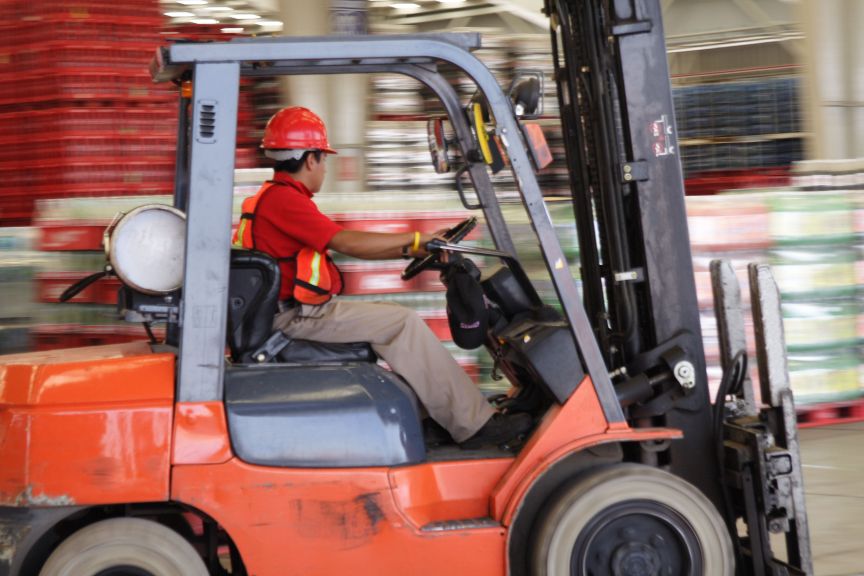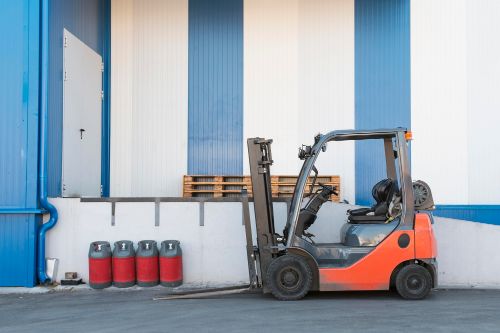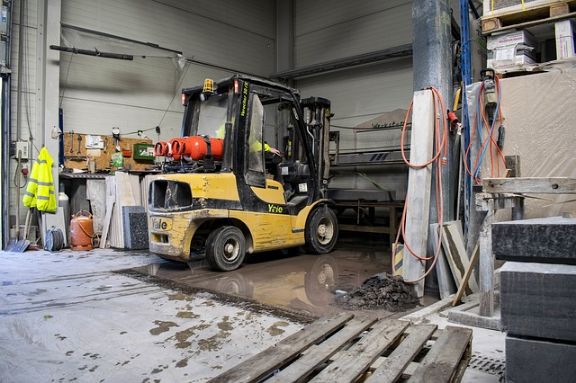
Propane, having a chemical formula of C3H8, also known as LPG, is widely used in many commercial applications such as powering industrial forklifts because it has low vapor pressure making this gas ideal to be compressed into the liquid inside a cylinder at room temperature.
But what kind of propane do forklifts use? To give a straight answer to this, HD-5 is the kind of propane gas that is used by propane-powered tools and heavy equipment such as a forklift. HD-5 is suitable to power forklifts because of its mixture of a minimum of 90% propane and a maximum of 5% propylene. In that mixture, propylene doesn’t gum up inside the IC engine during combustion.
HD-5, being a widely used grade of propane, at least in the US, is readily available for commercial purposes because 90% of the gas in the market is domestically produced. In fact, 48 million households and businesses use this grade for various applications – that includes fuel forklifts. If you order propane tanks from your local dealer, if you ask what grade of propane they offer, they would gladly say it is HD-5.
Other advantages of making propane ideal for power forklifts are friendly to the environment as it burns generates low greenhouse gas emissions, the gas is non-toxic making the equipment suitable even for indoor use and the gas is cheaper than gasoline or diesel.
Read related article: Does a Propane Forklift Produce Carbon Monoxide?
What is propane?
Propane, also known as liquefied petroleum gas (LPG), is a hydrocarbon gas that exists in its natural state as a volatile liquid. It is a byproduct of natural gas processing and petroleum refining. Due to its clean-burning nature, it’s used as a fuel in a multitude of applications including home heating, cooking, and as a fuel for vehicles and industrial equipment.
The molecular formula for propane is C3H8, making it one of the simplest hydrocarbons in use. Its properties allow it to be stored and transported under pressure as a liquid, but when released, it quickly vaporizes and expands, making it ready for combustion.
How is propane graded?
Propane is graded based on its purity and intended use. In the U.S., the two most common grades of propane are HD-5 and HD-10. These grades are determined by the propane’s propylene content and other specifications set by the American Society for Testing and Materials (ASTM).
- HD-5 (High Purity): This is the most common grade of propane used in the U.S. for all purposes, including vehicular fuel. As per the specifications, HD-5 propane must contain at least 90% propane, with the balance primarily being composed of propylene. It can only have a maximum of 5% propylene, which is why it’s termed “HD-5.”
- HD-10 (California Only): This grade of propane is used only in California and allows for up to 10% propylene content. This slightly higher propylene content can affect combustion characteristics, which is why its use is limited.
In addition to these grades, there are other specifications such as commercial propane and industrial propane, but these are less common in consumer and vehicular applications. Each grade of propane has been developed to serve specific needs and applications, ensuring optimal performance and safety.
It’s also worth noting that propane quality can be affected by contaminants like water, air, and other hydrocarbons. Ensuring the propane meets the specific grade requirements is crucial for its intended application.
What are the different kinds of Propane?
| Grade | Mixture | Availability | Use |
| HD-5 | Min. 90% Propane Max. 5% Propylene 5% other gases (Methane, butane, etc) | Commercially & widely available in all states | Vehicles, equipment, homes, appliances, industrial use |
| HD-10 | Min. 90% Propane Up to 10% Propylene | Abundant in California | Industrial, not suitable for vehicles |
| Commercial | Up to 49% propylene and other gases (propylene, butanes and methane) | Not used in vehicles, not widely available | Commercial heating |
Read related article: How to Choose the Correct Propane Forklift Tank?
HD-5 Propane: The Gold Standard for Forklifts
Composition and Characteristics:
- Composition: HD-5 propane, as the name suggests, consists of a minimum of 90% propane. The remaining composition is mainly propylene, with its content restricted to a maximum of 5%. Any additional constituents are usually other gases found in smaller amounts.
- Characteristics: The high propane content ensures a clean and efficient burn. HD-5 has consistent properties, making it reliable for applications where performance predictability is vital.
Why HD-5 is Preferred for Forklifts:
- High Purity: The elevated propane content ensures that the fuel burns cleaner, producing fewer emissions and pollutants. This is especially crucial for forklifts operating indoors where air quality is a significant concern.
- Consistency in Performance: Forklift operators rely on consistent machine performance for tasks like lifting and moving heavy loads. The predictable burn rate and energy output of HD-5 propane ensure that forklifts operate at a consistent power level, preventing unexpected drops in performance.
- Safety Considerations: The lower propylene content in HD-5 reduces the risk of engine knocking. Engine knocking can lead to engine damage and, in extreme cases, can pose safety hazards. With the rigorous demands placed on forklifts, using a reliable and safe fuel like HD-5 propane is paramount.
HD-10 Propane: Not Commonly Used for Forklifts
Composition and Why It’s Different from HD-5:
- Composition: HD-10 contains up to 10% propylene, allowing for a slightly higher propylene content compared to HD-5. This means it can have as little as 90% propane, with the rest being propylene and minor gases.
- Difference from HD-5: The primary difference lies in the propylene content. HD-10’s increased propylene percentage can lead to different combustion characteristics, which can influence engine performance and behavior.
Potential Issues with Using HD-10 for Forklifts:
- Variability in Performance: The increased propylene content can lead to variability in combustion rates. This can result in inconsistent power output, making forklift operations less predictable. For tasks requiring precision, such as lifting delicate items or navigating tight spaces, inconsistent performance can be problematic.
- Potential for Engine Knocking: Engines designed for HD-5 propane might experience knocking when fueled with HD-10 due to its different combustion characteristics. Knocking is not just a nuisance; it can lead to wear and tear on the engine, reducing its lifespan and potentially causing operational hazards.
In summary, while both HD-5 and HD-10 are suitable for various applications, HD-5’s consistent performance and safety profile make it the preferred choice for forklifts.
Read related article: Do Forklift Propane Tanks Need to Be Recertified? (How Frequent)
The Importance of Using the Right Propane Grade
Selecting the appropriate grade of propane is crucial not just for the efficiency and performance of the equipment but also for its longevity and the safety of its operators. Below, we delve into the reasons why using the right propane grade is of paramount importance:
1. Engine Longevity and Maintenance:
- Reduced Wear and Tear: Using the correct grade of propane ensures optimal combustion. Inappropriate or low-quality propane can result in incomplete combustion, leading to carbon deposits in the engine. Over time, these deposits can cause wear and tear on engine components, leading to premature engine degradation.
- Lower Maintenance Costs: Engines fueled with the right propane grade tend to require less frequent maintenance intervals. This means reduced costs over the life of the engine and longer periods between necessary tune-ups and overhauls.
- Extended Engine Life: In the long run, the right propane grade can significantly extend the life of the engine. Fewer contaminants and consistent combustion characteristics mean less strain on the engine’s internal components.
2. Performance Consistency and Efficiency:
- Predictable Power Output: Using a consistent grade of propane like HD-5 ensures that the equipment delivers a predictable power output, essential for operations requiring precision and reliability.
- Optimal Fuel Efficiency: The right propane grade burns efficiently, ensuring that the engine extracts the maximum amount of energy from every unit of fuel. This not only leads to cost savings but also contributes to reduced emissions.
- Fewer Operational Interruptions: Equipment running on the correct propane grade is less likely to experience hiccups, stalling, or other interruptions caused by fuel inconsistencies. This means smoother operations and less downtime.
3. Safety Concerns:
- Reduced Risk of Engine Knocking: As discussed earlier, engine knocking can be a result of using the wrong propane grade. This is not just an operational concern but also a safety risk, as knocking can cause engine components to fail, potentially leading to accidents.
- Lowered Emission of Harmful Pollutants: Using the appropriate grade ensures cleaner combustion, resulting in fewer harmful emissions. Especially for equipment operated indoors, like many forklifts, this is crucial to maintain a safe working environment.
- Prevention of Equipment Malfunction: An engine fueled with the wrong propane grade can malfunction in unpredictable ways, posing risks to the operator and those in the vicinity. Consistent fuel quality is a foundational aspect of ensuring safe operations.
The choice of propane grade is not a mere technical detail but a pivotal decision affecting the performance, longevity, and safety of equipment. As such, it’s essential to make an informed choice and ensure that the propane being used aligns with the equipment’s specifications and requirements.
Tips for Ensuring You’re Using the Right Propane for Your Forklift
Ensuring that your forklift is powered by the correct grade of propane is not just about optimizing performance—it’s about ensuring the longevity and safety of the equipment. Here are some steps to ensure you’re using the right propane:
- Asking the Supplier About the Grade:
- Always clarify the grade of propane you’re purchasing. A reliable supplier should readily provide this information.
- Request a Certificate of Analysis (COA) if available. This document gives detailed information about the propane’s composition and confirms its grade.
- Regularly Inspecting the Propane for Contaminants:
- Before refilling, visually inspect the propane for any discoloration or cloudiness, which might indicate contamination.
- Use filters during refueling to catch potential contaminants.
- Regularly inspect and clean the storage tanks to prevent any buildup of residues or contaminants.
- Knowing the Signs of Using the Wrong Propane Grade:
- Listen for engine knocking or unusual sounds during operation. This might indicate combustion issues related to the propane’s quality.
- Monitor for reduced performance or erratic behavior in the forklift, such as inconsistent power or stalling.
- Regularly check emission quality. Darker or more pungent emissions can be a sign of sub-optimal propane combustion.
Read related article: What are the Forklift Propane Tank Inspection Requirements?
Where to Buy HD-5 Grade Propane for Your Forklift Operation Needs
Before you dial a nearby dealer in your location, it is better to contact the National Propane Gas Association to get a referral from a reputable supplier. The association maintains a listing of reputable companies in every state, just give them your zip code, and they then provide the closest propane dealer in your area.
Another way to get recommendations from friends or colleagues – they definitely can give honest feedback about the company they’re getting their propane from. Though online company reviews are available to make a decision, we would not suggest relying on such reviews since data can be altered.
The demand for HD-5 propane is on the rise, with the increased use in homes and commercial and industrial settings, you would expect its price to go up as well.
What are the Advantages of Propane-Powered Forklifts?
Propane-powered forklifts are a powerful and efficient choice for any business owner looking for an alternative to gasoline and diesel-powered forklifts. This kind of forklift has many advantages over other types of trucks:
- Cost-effective – propane offers better fuel efficiency and is much cheaper as well compared to their diesel and gasoline counterparts, which means business owners like you can save a lot of money on their fueling costs significantly.
- Less strain for the operator – forklifts that run on propane produce much less vibration while running and cause less strain on the operator’s back and body during long periods of use.
- Environmentally friendly – propane is a clean burning fuel, which means that it produces fewer emissions than the other fuels mentioned above.
- Easy to handle – propane gas is easier to handle than gasoline or diesel fuel because it doesn’t need a station in the workplace for refueling as those fuels do. Since this is contained in a cylinder, it is more portable to handle.
- Produces more or exactly the same power compared to other fuel types – the forklift engine is internal combustion, which burns fuel to produce power. Propane is flammable, has a 105 octane rating, just like its counterparts, and produces the same power to run the vehicle and to lift heavy loads even on an incline.
- Clean-burning – propane, having just a maximum of 5% propylene, a chemical to use plastic, burns cleanly and produces fewer deposits that could gum up inside the IC engine. This ultimately leads to a longer-running engine.
FAQs
1. What is HD5 propane used for?
HD5 propane is the most common grade of propane used in the United States. Its applications include:
- Vehicular Fuel: HD5 propane is used to power vehicles equipped with propane engines, including some buses, fleet vehicles, and cars.
- Home Heating: Many residential properties, particularly those in rural areas without access to natural gas lines, use HD5 propane for space heating and water heating.
- Cooking: Propane-powered stoves and grills typically use HD5 propane due to its high purity.
- Refrigeration: Some refrigerators, especially those in RVs and off-the-grid homes, operate using HD5 propane.
- Industrial Applications: Many industries use propane-powered equipment and forklifts, typically fueled by HD5 propane.
- Agricultural Use: Propane is used in various farming applications, such as grain dryers and heaters, and HD5 is the preferred grade for these uses.
2. What is the grade of propane in the HD5?
HD5 stands for “High Purity” propane. The specifications for HD5 propane are:
- It must contain at least 90% propane.
- The propylene content in HD5 propane cannot exceed 5% (hence the “5” in “HD5”).
These characteristics ensure a consistent and efficient burn, making HD5 suitable for a wide range of applications.
3. What is the best grade of propane?
The term “best” grade of propane depends on the specific application. For most consumer and commercial applications, HD5 is considered the best because of its high propane content and low propylene percentage. Its consistent and efficient burn, coupled with its widespread availability, makes it a top choice.
To Make a Conclusion
The engine of a forklift, like any machinery, is designed to operate at its best when fueled with the right grade of propane. HD-5, with its high purity and consistent combustion characteristics, stands out as the ideal choice for forklifts.
While it might seem like a minor detail, the grade of propane used can have long-term implications on the health of the engine, its performance, and, importantly, the safety of the forklift’s operators and surroundings.
In this light, regular maintenance and vigilance aren’t just about keeping the machinery running; they’re about ensuring that the forklift operates optimally, safely, and efficiently. Ensuring the use of HD-5 propane and being proactive in equipment checks are foundational steps toward this goal.

Mike is an experienced propane technician with over 15 years of professional experience in the field. He has dedicated his career to helping customers with their propane needs, from installation to maintenance and repair. Together with Jeremy, he co-founded this website to provide useful information and guidance to customers seeking reliable propane services.




